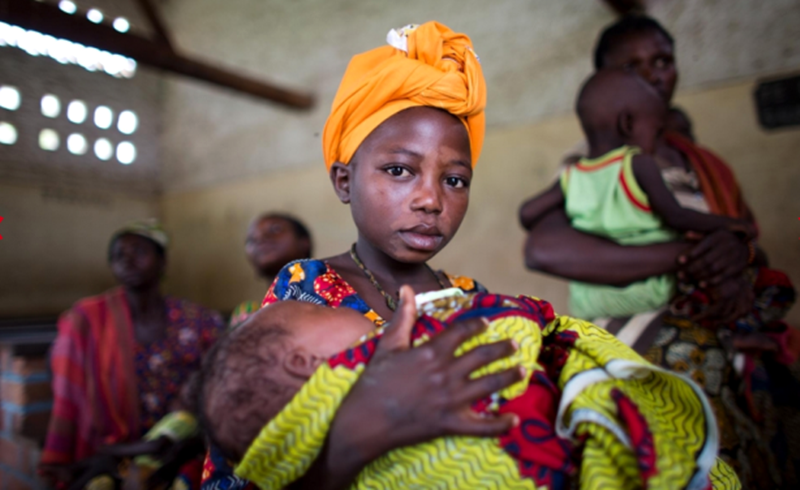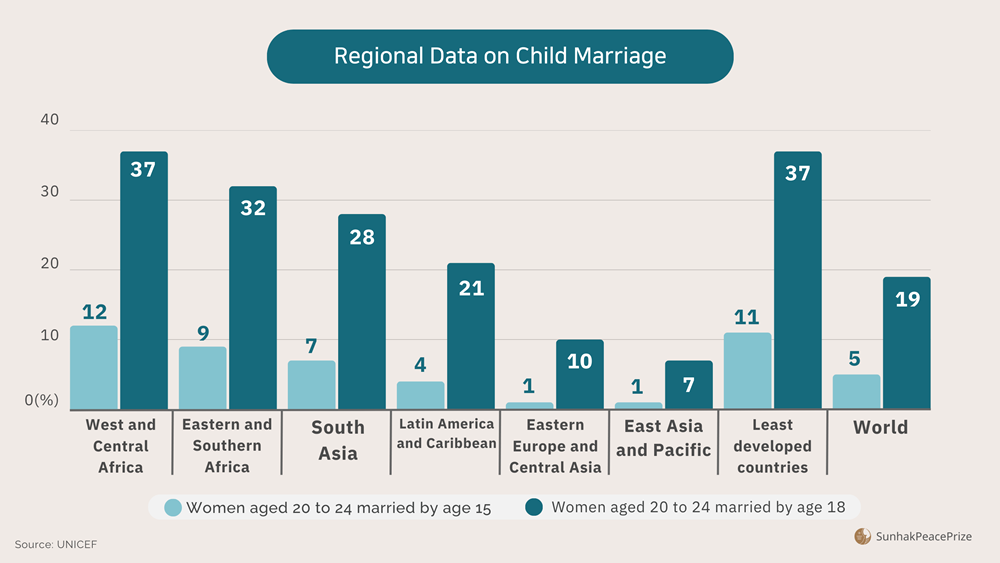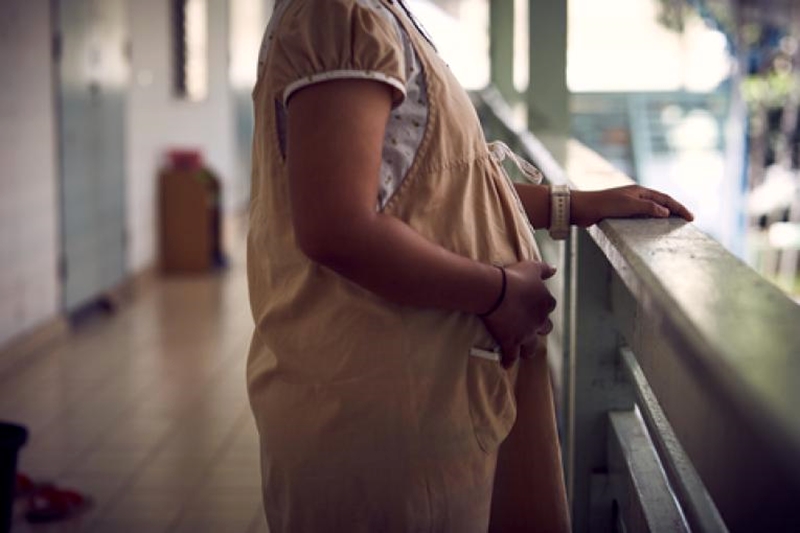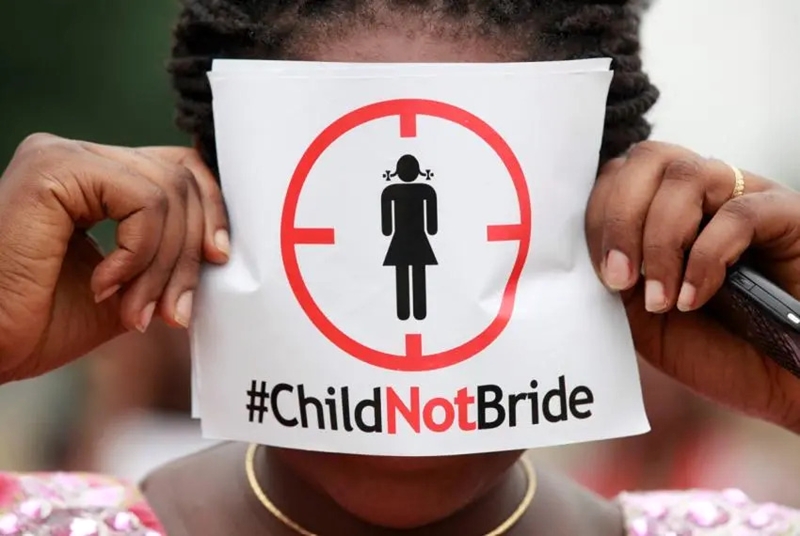Child marriage refers to marriage between a child under the age of 18 and an adult or another child, which in most cases are forced marriages. This article will explore the current facts and problems associated with child marriage.
―
Q. What is child marriage?
―
A. Child marriage refers to marriage between a child under the age of 18 and an adult or another child. And in most cases, these marriages are forced marriages.
Although many countries have laws banning child marriage, it continues to be practiced in several regions. Reasons include deeply rooted traditions, cultural norms, religious beliefs, and economic pressures.
In countries like Central Africa, Niger, Bangladesh, Chad, and Mali, three out of ten girls under the age of 18 are married in childhood.
Child marriage is a violation against basic human rights, and it severely restricts the rights of women and girls in areas such as education, health, and economic opportunities. To combat this issue, the United Nations has set a goal to end child marriage by 2030 and is actively working towards this objective.

(Source : face2faceafrica)
―
Global data on child marriage
―
Although there has been progress, child marriage remains a significant concern, and approximately 12 million girls are married as children every year.
Child marriage is an issue that persists worldwide, but it is especially prevalent in the regions of Africa, South Asia, and Latin America.
UNICEF conducts extensive statistics and research on child marriage and publishes an annual report “The State of the World’s Children.” Here is what their latest report reveals about the global data on child marriage.
1. Global Data on Child Marriage
· Approximately 115 million girls worldwide are married before the age of 18.
· More than 2 in 10 girls will be married before reaching adulthood.
· In the least developed countries, 4 in 10 girls marry before the age of 18, and 12% marry before the age of 15.
2. Regional Data on Child Marriage

(Source: UNICEF)
· Eastern and Southern Africa: 3 in 10 girls marry before the age of 18.
· South Asia: 3 in 10 girls marry before the age of 18. Child marriage remains a common practice, especially in Bangladesh, Nepal, Pakistan, and India.
· Latin America and the Caribbean: 2 in 10 girls marry before the age of 18.
Fortunately, child marriage is on the decline on a global level. South Asia has shown the greatest amount of improvement over the last decade, with the risk of child marriage dropping by more than a third from 50% to less than 30%.
―
Risks involved with child marriage
―

(Source : UNICEF)
Child marriage causes the following problems and risks.
1. Health risks: Pregnancy and childbirth during adolescent years pose a great health risk, with a higher risk of miscarriage and death.
· Pregnancy and childbirth-related risks: Adolescent women aged 15-19 are more likely to die in labor than adult women, and pregnancy and childbirth is one of the leading causes of death for women under the age of 15. According to UNICEF, girls under the age of 20 face a 50% higher risk of death in childbirth than women aged 20-24.
· Risk of sexually transmitted infections (STI): Girls are often married to older men in child marriages, putting them at a higher risk of exposure to HIV and other STIs.
· Psychological health: The stress and strain of child marriage can increase the risk of depression, anxiety, self-harm, and even suicide.
2. Lack of education: Most girls married in childhood drop out of school and lose their access to educational opportunities.
· School dropout rates: According to data from UNICEF, the majority of girls who marry before the age of 18 do not complete basic education, and the percentage of girls completing secondary education is even lower.
· Lack of access to healthcare: Girls who marry at a young age have less access to information and resources related to healthcare, which lead to problems such as poor nutrition and iron deficiency.
3. Domestic violence: Victims of child marriages have a higher risk of being exposed to domestic violence.
· Increased exposure to violence: According to a study by WHO, women who married as children are more likely to experience physical, sexual, and emotional violence.
· Power imbalance due to difference in age: In child marriages, the age difference is often large, which creates a power imbalance in the home and increases the risk of violence.
―
Efforts to End Child Marriage
―

(Source : Human Rights Watch)
Child marriage robs girls of their childhood and jeopardizes their well-being. To end this harmful practice, we need to focus on the following strategies.
1. Strengthen legal regulations
Governments should enact laws that prohibit child marriage and strictly enforce them.
In 2015, the United Nations General Assembly adopted the first substantive resolution recognizing child marriage and forced marriage as a human rights violation, Strengthening efforts to prevent and eliminate child, early and forced marriage.
This resolution recognizes the negative effects of child marriage and calls for national, regional, and international action to prevent and end child marriage.
2. Expand education
Education is the most effective means of preventing child marriage. Girls should be provided with education that makes them aware of their rights and values.
3. Raise social awareness
We need to change societal perception about child marriage. Awareness campaigns and education programs can help achieve this. Leaders and policymakers in communities where child marriage is prevalent should work together to raise awareness and change traditional practices.
―
NGOs fighting child marriage
―
Several NGOs around the world are tackling the issue of child marriage. Girls Not Brides is one of the leading organizations, an international network for ending child marriages in all parts of the world.
Girls Not Brides was established in 2011 and has partnered with more than 1,000 organizations in more than 100 countries to run a variety of campaigns, educate girls, and raise awareness about the dangers and risks of child marriage.
One of its most notable achievements is working with governments to successfully change laws against child marriage in several countries.
To learn more about Girls Not Brides and their activities to end child marriage, watch this video.
(Source : Girts Not Brides)
Child marriage has long been seen as a personal issue, but it’s a global problem that affects us all. We want to create a world where every girl can grow up in a healthy environment, free from the devastating consequences of child marriage. And we all share the responsibility to address this issue and make a positive change.
“To change anything in this world, you need to be educated, you have to be informed, and you have to be aware.
So education is the key.”
-Waris Dirie, Sunhak Peace Prize Laureate -
Learn More: |
References: Child Marriage | Plan International Why it happens - Girls Not Brides Child Marriage - Facts, FAQs &How to Help | Child Brides | World Vision Australia |
Written by Sharon Choi
Director of Planning
Sunhak Peace Prize Secretariat
Translated by Hyang Oh


